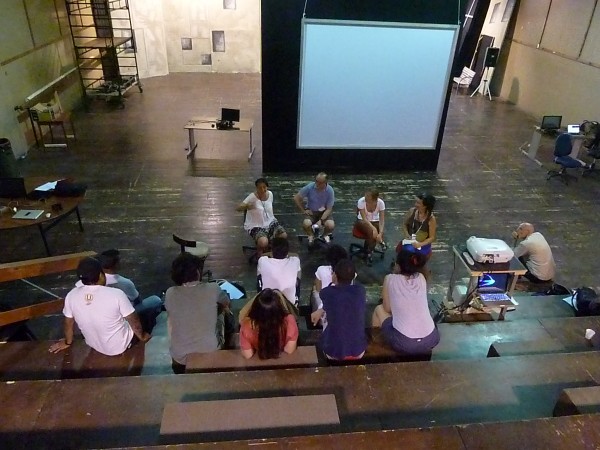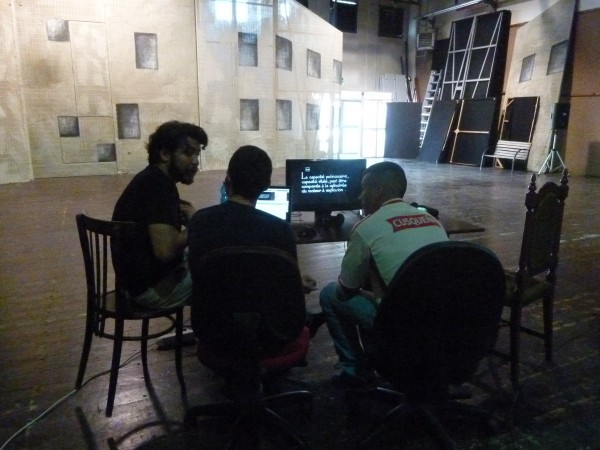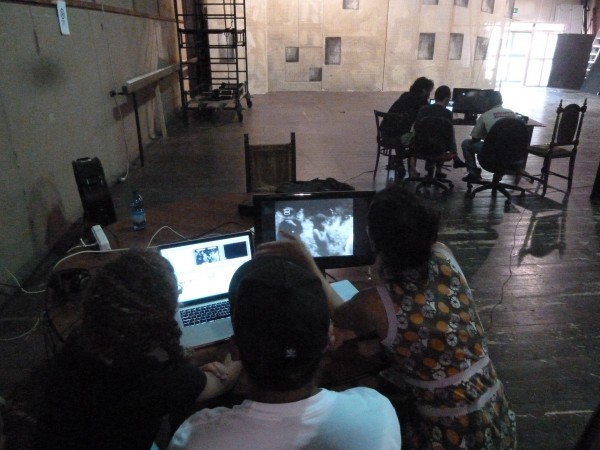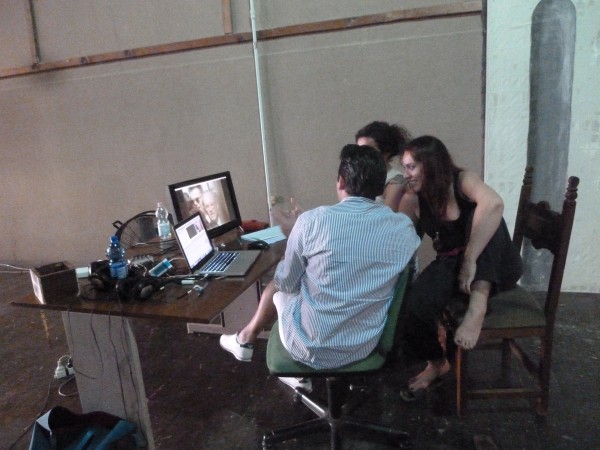Artistic experiences - process
Exploration of the intimate narrative with archive footages around the body issue – Milan
Place of the workshop: Theatre inside Milano-Bollate’s prison
Partners involved:
Lieux Fictifs:
РJoseph C̩sarini, film director and trainer
– Emmanuelle Raynaut, visual artist and trainer
– Pascal Rehnolt, assistant film director and editor
– Aurora Vernazzani, intern film director assistant and trainer
Coopérativa sociale e.s.t.i.a :
– Michelina Capato, artistic director, stage director
– Beatrice Zecchinelli, videomaker and trainer
Institut National de l’Audiovisuel:
РMireille Maurice, regional director of INA Mediterran̩e
Audiences and territories involved:
Four inmates participating to e.s.t.i.a. theatre training workshops inside Bollate’s prison
Two participants from the outside, students from IULM
Methodology proposed:
Collaborative creation of short films made from archive images, working in duo.
Work around the collaboration and the exploration of the intimate narrative, through the body issue.
Archives used : Archives from the Institut National de l’Audiovisuel collection
Results : Three short-films between 2 and 4 minutes length: « Affamati », « Lottare sospesi », «Una vita piena di speranza».
Summary of the methodology proposed:
The proposal made to participants was to internalize the archives images (coming from INA collection) proposed in an intuitive, sensitive, not rational way, on the thematic of the body. After viewing a corpus made of one hour of archives, the trainers suggested the group to let one image rise, and to choose one missing image.
The initial difficulty has been to avoid the trap of a narration that would be over-built, over-logical. Trainers tried to bring the participants toward a sensitive experiment of the image material, in doing so sharpening the intentions of the duos. Two extracts from “La Rabbia†has been proposed, one by Pasolini and the other by Guareschi, in order to support the scope concerning the fact to build a narrative, a personal point of view from identical images. The transition toward the editing station facilitated the work process, as participants have been able to realize the possibilities offered by the software.
In each duo, there has been an interesting phenomenon of openness: each person let the image of the other be present without giving up its own one, for example thanks to the alternate editing or to the images superimposed. The work around sound strengthened the complicity inside duos, creating a balance that brings strength and intensity to the short films. One of the results has been a shift from participants thanks to the work of image transformation and the one of collaborative creation in duo: their first relationship with the image has been changed in most of the case.)
Lieu : Plateau de théâtre du Centre de détention de Milano Bollate
Partenaires impliqués:
Lieux Fictifs:
РJoseph C̩sarini, r̩alisateur et formateur,
– Emmanuelle Raynaut, artiste et performeuse,
РPascal Rehnolt, assistant r̩alisation et monteur,
РAurora Vernazzani, assistante r̩alisation et formatrice,
Cooperativa sociale e.s.t.i.a:
РMichelina Capato, directrice artistique, metteuse en sc̬ne et formatrice,
РBeatrice Zecchinelli, formatrice et vid̩aste,
Institut National de l’Audiovisuel :
– Mireille Maurice, déléguée régionale de l’INA Méditerranée.
Publics et territoires impliqués :
Quatre personnes détenues stagiaires des ateliers de théâtre menés par la coopérative sociale e.s.t.i.a. dans la prison de Bollate
Deux personnes du dehors, étudiants de l’IULM
Méthodologie proposée :
Création en groupe de court-métrage à partir d’images d’archive.
Réalisation d’un court-métrage en binôme. Travail autour de la collaboration et exploration du récit de l’intime.
Archives utilisées : Archives de la collection de l’Institut National de l’Audiovisuel
Résultats du workshop: trois court-métrages d’une durée de deux à quatre minutes: « Affamati », « Lottare sospesi », « Una vita piena di speranza ».
Résumé de la méthodologie proposée :
La proposition faite aux participants eÌtait au deÌpart, de s’approprier des images d’archives (provenant de l’INA) proposées de manière intuitive, sensible, non rationnelle, sur le thème du corps. Après le visionnage d’un corpus d’une heure, les formateurs ont suggérÃ©Ì au groupe de laisser remonter une image, et de choisir une image marquante.
La difficultÃ©Ì initiale a eÌteÌ d’éviter le piège d’une narration trop construite, trop logique. Les formateurs ont essayÃ©Ì de rediriger les participants vers une expérience sensible de la matière image, tout en aiguisant les binômes par rapport aÌ€ leurs intentions. Deux extraits de La Rabbia l’un reÌaliseÌ par Pasolini et l’autre par Guareschi ont eÌteÌ proposeÌs pour eÌtayer le propos sur le fait de construire un récit, un point de vue personnel aÌ€ partir d’images identiques. Le passage aux postes de montage a facilitÃ©Ì le processus de travail, car les participants ont pu se rendre compte des possibilités offertes par le logiciel.
Dans chaque binôme il y a eu un phénomène intéressant d’ouverture : chacun laissait la place aÌ€ l’image de l’autre sans renoncer aÌ€ la sienne, aÌ€ l’aide, par exemple, du montage alterneÌ ou de la superposition d’image. Le travail sonore a renforcÃ©Ì la compliciteÌ dans le binoÌ‚me, en creÌant un eÌquilibre qui donne force et intensiteÌ aux court-meÌtrages. Un des reÌsultats obtenus a eÌteÌ un deÌplacement des participants par le travail de transformation de l’image et par le travail de creÌation collaborative en binoÌ‚me par rapport aÌ€ leur premier veÌcu de l’image, qui a eÌteÌ transformeÌ dans la plupart des cas.




